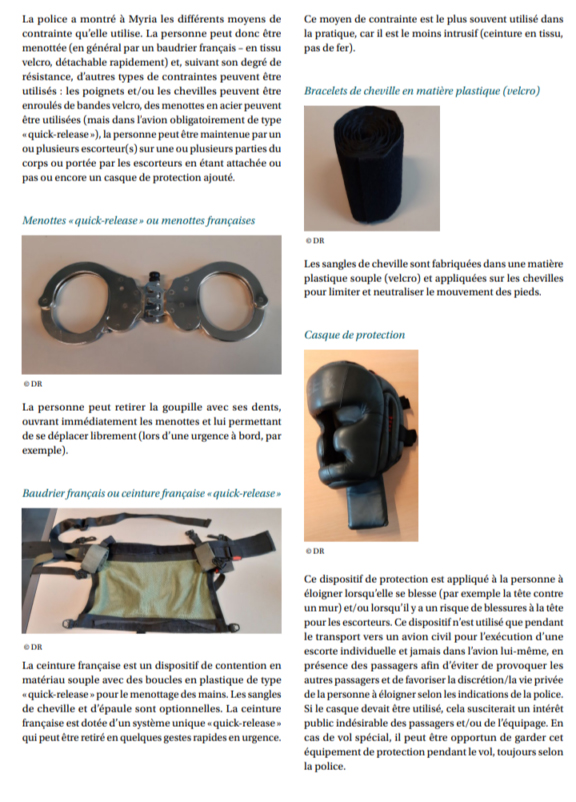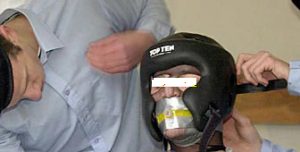06/12/2021
As we put the pieces together for this article, reality overtook the atrocities we were about to recount: Abdel Latif, a young man from Tunisia, was killed on 28 November, after three days in a state of mechanical restraint in Rome’s San Camillo hospital. State racism is rampant and what Abdel Latif saw of Italy was segregation in Lampedusa, imprisonment on a quarantine ship, detention in the deportation centre of Ponte Galeria in Rome, restraint in the psychiatric ward at the San Camillo.
Two of the imprisonments that led to Abdel Latif’s death have the Italian health system as a backdrop, for the rest there are the operators of humanitarian host organisations.
 Recent mobilizations against psychiatric restraint offered us some reflections and we looked for information concerning the debate on mechanical restraint, a practice that the State declares it wants to abolish with a three-year implementation which should end in 2023. It must be noted that in institutional documents themselves, evaluations start off from data and notes dating back to 2001 and that from these analyses they come to “recommendations” and “suggestions” which since, 20 years on haven’t had any practical confirmation: people continue to die with violence.
Recent mobilizations against psychiatric restraint offered us some reflections and we looked for information concerning the debate on mechanical restraint, a practice that the State declares it wants to abolish with a three-year implementation which should end in 2023. It must be noted that in institutional documents themselves, evaluations start off from data and notes dating back to 2001 and that from these analyses they come to “recommendations” and “suggestions” which since, 20 years on haven’t had any practical confirmation: people continue to die with violence.
Each institutional document has to take into consideration the violation of individual freedoms, torture, ineffectiveness in terms of improvement of health conditions and the fact that mechanical restraint worsens the state of a person subjected to it to the point of determining their death. Protocols based on the assumption that “it is neither a health measure nor a medical act, as it has no therapeutic, diagnostic or pain treatment goal” confirm “the violent nature of psychiatric cure” and a worsening of the social stigma for those who have difficulties, but as for today there is no monitoring of these practices of torture in psychiatric structures (let alone prisons, RSAs and CPRs). Already in the past a register was suggested, not imposed, which would take note of the modalities and timing of restraints. It doesn’t take much imagination to believe that all this happens with physical violence, sedation and neglect because the supporters of mechanical restraint think that the risk to the safety of health operators and lack of personnel are good reasons to torture and kill people. The institutions have no way to compare these convictions with other health structures that don’t use mechanical restraint because confidentiality is immense and without control.
In the guidelines that the State declares it wants to adopt in order to go over mechanical restraint, besides staff training, there are transparency and access to loved ones for people held in psychiatric structures because part of restraint consists in reclusion. Now, looking at the latest person killed by restraint, probably access to loved ones would have been impossible given the border controls. That psychiatric control – through coercive, voluntary and involuntary administration of psychotropic drugs – concerns the lives of people detained in deportation centres, certainly we are not the first to know [See 1 and 2].
People in detention have always denounced the presence of psychotropic drugs in their food and the use of these drugs as the only “cure” offered besides paracetamol: a pamphlet recently  published by nocprtorino.noblogs.org sums up the current health management in CPRs and makes clear reference to psychiatric control. In the past we also denounced forced injections of psychotropic drugs in the CPR of Ponte Galeria; and a complaint by the cooperative Auxilium led to the preventive seizing of the article page: but how many other aspects of psychiatric control concern the violence inflicted on migrants?
published by nocprtorino.noblogs.org sums up the current health management in CPRs and makes clear reference to psychiatric control. In the past we also denounced forced injections of psychotropic drugs in the CPR of Ponte Galeria; and a complaint by the cooperative Auxilium led to the preventive seizing of the article page: but how many other aspects of psychiatric control concern the violence inflicted on migrants?
Mechanical restraint is employed alongside sedatives in deportation  procedures in many European and non-European countries. Plastic handcuffs, scotch tape to bind hands and feet and to shut mouths, helmets, straps, chairs with ties… a chilling list that has led to the death of a number of people, some of them becoming known after protests, such as Semira Adamu – killed with a pillow on her face on a AirFrance flight as she was being deported to Nigeria from Belgium – and Jimmy Mubenga – suffocated on a deportation flight from the UK to Angola.
procedures in many European and non-European countries. Plastic handcuffs, scotch tape to bind hands and feet and to shut mouths, helmets, straps, chairs with ties… a chilling list that has led to the death of a number of people, some of them becoming known after protests, such as Semira Adamu – killed with a pillow on her face on a AirFrance flight as she was being deported to Nigeria from Belgium – and Jimmy Mubenga – suffocated on a deportation flight from the UK to Angola.
Conclusions
Mobilizations against mechanical restraint clearly describe a reformist tendency to conceal psychiatric violence and the danger of substitution with more pharmacological restraint in a country convinced that electroshock and mental asylums belong to the past.
While the Guarantor delegation that went to Ponte Galeria say they intend to make clarity on the causes of Abdel Latif’s death and wonder whether constraint leads to death, we believe that clarity is already there. Everybody dies of “cardiac arrest” but the stigma and criminalization lead to isolation and people denied contacts can be subjected to any kind of treatment.
From the stories told by the people involved, we know that it is control mechanisms themselves and then the institutional places of segregation (boats, hotspots, reception centres, CPRs, psychiatric wards) themselves that create the conditions for great psychological suffering. What creates immense suffering is the stress of not being able to set off in order to improve one’s life, the fact of having to find thousands of euros to pay for the journey, the responsibility of not disappointing families and friends and the hope of being able to send money back home soon, fear during a crossing where one risks one’s life and sees one’s companions die, the torture inflicted in concentration camps, and once in Italy, just as one thought one had made it, other procedures which are even more incomprehensible because they are in a different language, more jails and violence in the most absolute isolation, as happens in CPRs where it is not even possible to hear one’s loved ones by telephone.
Attempts at protesting against this inhuman system are often repressed on health grounds, labelling those who demand freedom as insane people to be subjected to compulsory treatment and restraint.
There must be no silence in the face of yet another killing.
———————-
